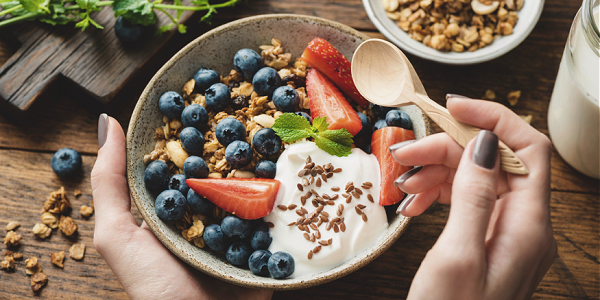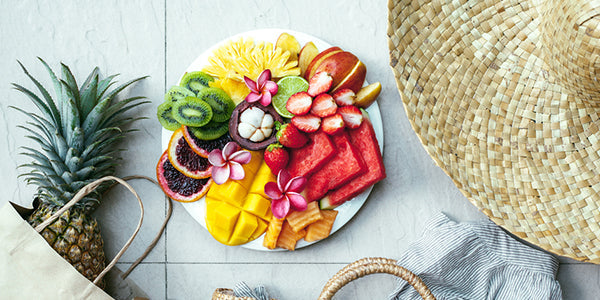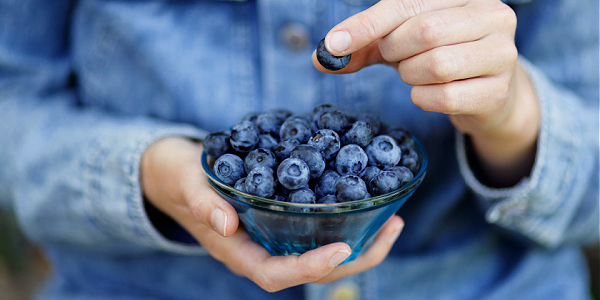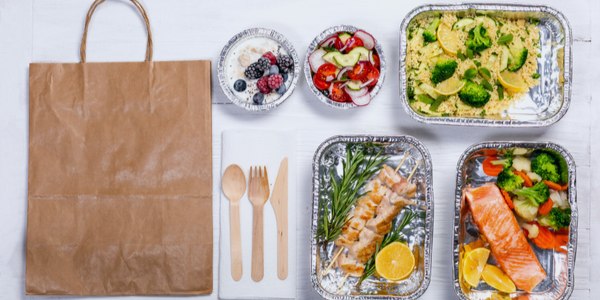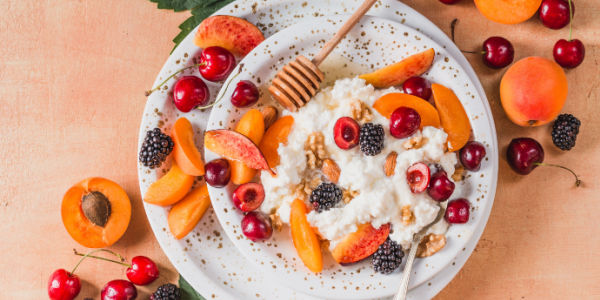
If you're looking for sweetness without major blood sugar spikes, meet low-glycemic fruits!
Plus, low glycemic index fruits don’t just make sense individuals with diabetes. Fruits can be a sensible choice for healthy eaters everywhere.
Keep reading for a list of low-glycemic fruits sure to satisfy and nourish.
What Is the Glycemic Index?
The glycemic index (GI) measures how quickly a certain food increases blood glucose levels—also known as blood sugar. Foods are ranked on a scale from 0-100, with o being low and 100 being high.
Items are categorized using the following GI ranges:
• Low: 1 to 55
• Medium: 56 to 69
• High: 70+
High GI foods cause a rapid rise in blood sugar. Often they are high in refined carbohydrates or sugars, which are absorbed into the bloodstream relatively quickly.
On the other hand, low-GI foods are digested more slowly. This means they also cause a slower rise in blood sugar. They are often less processed and contain higher fiber, protein, and healthy fats.
Factors Affecting GI
Like any measure, GI has its limitations. Although it isn’t perfect, it’s still considered a helpful tool. For example, GI is based on foods eaten alone, on an empty stomach. Pairing a high-GI food with a protein or fiber source may lower a meal's glycemic impact.
Also, GI isn’t necessarily based on normal serving sizes. It accounts for a blood sugar increase following consuming 50 grams of carbohydrates (usually with fiber components removed).
In other words, a higher GI for some fruits may be misleading since a normal serving contains fewer carbohydrates per cup.
Bananas are a great example of how carbohydrate content can change depending on what unit you’re looking at. A ripe, yellow banana ranks 51 according to GI, which is considered on the high end of the low range. While a cup of mashed banana contains about 50 grams of carbohydrates, one medium banana (a more common serving size) contains only 27 grams.
Interestingly, ripeness can also affect GI ranking. An under-ripe, greener banana ranks around 40, while a ripe banana ranks around 50.
Glycemic Index vs. Glycemic Load
It’s important to note that the glycemic index differs from glycemic load (GL). GL helps to correct the limitations of GI by taking portion size into account.
Keep in mind that GL also operates on a different scale. A GL under 10 is low, and a GL over 20 is high. Using Gl and GL as a reference can help determine what foods are right for you.
Benefits of Low Glycemic Fruits
Perhaps the most obvious benefit of low glycemic fruits is that they help balance blood sugar levels. However, “nature’s candy” has benefits beyond this. Fruits contain plenty of beneficial nutrients and compounds, such as antioxidants and natural sugars.
A balanced source of carbohydrates, such as low-GI fruits, can help provide a steady energy source. Instead of causing a sharp spike in blood glucose, low-GI fruits can sustain energy levels by being digested and absorbed more slowly.
Knowing what fruits are low on the glycemic index is invaluable information for people with diabetes. Especially for those with type 2 diabetes, fruits can provide a sweet snack that can also help encourage weight loss. Research suggests a diet rich in low GI foods may also help lower blood pressure.
Low-Glycemic Index Fruits
Convinced of the benefits? The following fruits have low GI scores in addition to amazing flavors.
1. Apples
Apple Glycemic Index: 39
Apples have a GI of 39 but are surprisingly sweet. Beyond their ability to lower fasting blood sugar as part of a healthy diet, apples have also been studied for their potential to lower LDL (“bad”) cholesterol and triglycerides while raising HDL (“good”) cholesterol. Eating an apple with the peel provides a bit of fiber to help balance blood sugars, too.
2. Apricots
Apricot Glycemic Index: 42
Apricots have a GI of 42 and are considered a superfood. It contains compounds with antioxidant and anti-inflammatory properties, and may even help prevent chronic disease development.
Thanks to soluble fiber, apricots can help stabilize blood sugar, lower cholesterol, aid weight loss, and improve digestion.
3. Blueberries
Blueberry Glycemic Index: 53
Long heralded as a heart-healthy food, blueberries may also be good for blood sugar. With a GI of 53 in the low category, blueberries are rich in compounds called polyphenols (known for their health benefits).
Recent research shows polyphenols may be crucial in balancing blood glucose levels and enhancing antioxidant activity.
4. Bananas
Banana Glycemic Index: 51
As mentioned above, bananas have a GI of 51 when ripe. Even though this is on the “higher” end of the low category, bananas are still a great choice. Mashed bananas can be used as a sugar substitute in some baking recipes.
5. Citrus
Lemons and Limes Glycemic Index: ~20
If you’re looking for something low on the GI scale, citrus may be one of the best picks. Limes and lemons rank rather low with a GI around 20, while oranges rank more towards medium at 45. A recent study suggests even the juice from citrus, such as lemons, can lower the glycemic response of a starchy meal or snack.
6. Grapefruit
Grapefruit Glycemic Index: 47
Technically another type of citrus, grapefruit has a GI of 47. It is abundant in flavonoids, known to have antioxidant, antidiabetic, and anti-inflammatory properties. Flavonoids are also responsible for grapefruit’s pleasant aroma, ruby red color, and recognizable flavor.
7. Grapes
Grape Glycemic Index: 50
Fresh, seedless grapes have a GI of 50. Although tiny, grapes are a powerhouse of nutrients, containing plenty of vitamins, minerals, and hydration. Eating them with a peel means you’ll also be getting a good source of fiber, and like apricots and prunes, grapes are considered helpful for digestion.
8. Guava
Guava Glycemic Index: 29
A tropical favorite, raw guava has a GI of 29. Nectar and juice are also popular, although added sugar may be in processed versions. Guava extract is examined by experts for its unique effects on blood sugar, particularly its ability to help people with diabetes lose weight and balance blood glucose.
9. Mango
Mango Glycemic Index: 48
Deceptively sweet, raw mangoes only have a GI of 48. Like guava, mangoes are a tropical delicacy with anti-diabetic and lipid-lowering activities. Anciently, mangoes were used medicinally, and are still used for their anti-inflammatory, antibacterial, and antiviral properties. In other words, mangoes are considered to be health-protective.
10. Nectarines
Nectarines Glycemic Index: 43
Next on the list is nectarines, which have a GI of 43. If you’ve never had a nectarine before, don’t be intimidated! They are considered cousins of the peach and are a stone fruit with smooth skin. One recent study even suggests using nectarines as a sugar substitute in starchy desserts to help make them more digestion-friendly.
11. Papaya
Papaya Glycemic Index: 38
Like guava (listed earlier), papaya is a tropical fruit that has become more trendy recently. Raw papaya has a GI of 38 and can be eaten raw when ripe.
From smoothies to salsas to salads, a dish prepared with papaya adds plenty of phytochemicals to the diet. Phytochemicals are special compounds that may be crucial to controlling fasting blood glucose for both healthy and diabetic people alike.
12. Pears
Pears Glycemic Index: 33
An under-ripe pear has a GI of 24, which is considered especially low for fruit. A more ripe or soft pear has a higher GI of 33, but is still categorized as “low GI.”
Some pears contain more natural sugars than others, so it may be helpful to do some research before heading to the store, especially if you’re diabetic.
13. Prunes
Prunes Glycemic Index: 29
Pitted prunes, which are dried plums, have a GI of 29. They are known for their health properties, chief among them being their use as a digestive aid. Although regularly recommended for older adults, prunes can be enjoyed by people of almost any age.
Due to a higher fiber concentration, prunes can also help lower cholesterol and blood pressure while balancing blood sugar.
14. Strawberries
Strawberries Glycemic Index: 40
Fresh, raw strawberries have a GI of 40, making them a blood sugar-balancing berry. Well-liked for their natural sweetness, strawberries can be eaten cold and raw or warmed and cooked.
With a high amount of antioxidants, vitamins, and phytochemicals, strawberries are useful for maintaining steady blood sugar levels. They may even stabilize blood pressure.
15. Tart Cherries
Tart Cherries Glycemic Index: 41
Tart (sour) cherries have a GI of 41 and have received much attention from the media lately. Though they have a more tart flavor, many consumers report a pleasant mix of sweet and sour tastes.
Basically, if you like fruits like blackberries or raspberries, you probably won’t mind the tart taste of these cherries. Tart cherry juice, in particular, has been studied for its ability to reduce fasting blood sugar levels significantly.
How to Enjoy Low-Glycemic Fruits
Remember, low GI doesn’t automatically equal “healthy.” It’s important to understand a food’s nutrient profile and search for foods that are both low GI and nutrient-rich to fit your lifestyle.
Try these tips to make healthy selections.
Compare Fruit Forms
Some forms of the same fruit may have a higher GI than others. For example, dried fruits, frozen fruit blends, or fruit juice may be more concentrated or contain added sugars. In any case, if the fruit comes with a label, you’ll want to look at it.
Keep an Eye on Portions
It’s possible to overeat a low-GI fruit, raising the overall glycemic impact of a snack or meal. Pay attention to the suggested serving size as a general guide.
Pair with Protein, Healthy Fats, or Fiber
If a low-GI fruit doesn’t naturally contain these components or falls higher within the low-GI category, you can always pair it with a food that will lower its glycemic impact. This tip is especially helpful when preparing blood sugar-friendly snacks—like cottage cheese and peaches.
Low-Glycemic Fruits: Lasting Thoughts
Satisfy your sweet tooth with low-GI fruits. Thanks to natural sugars, fruits have a taste that can’t be beaten, but also have nutrients that assist in balancing blood sugar.
Whether you’re managing diabetes or looking for a healthier eating pattern, low-GI fruits are worth adding to your menu.

